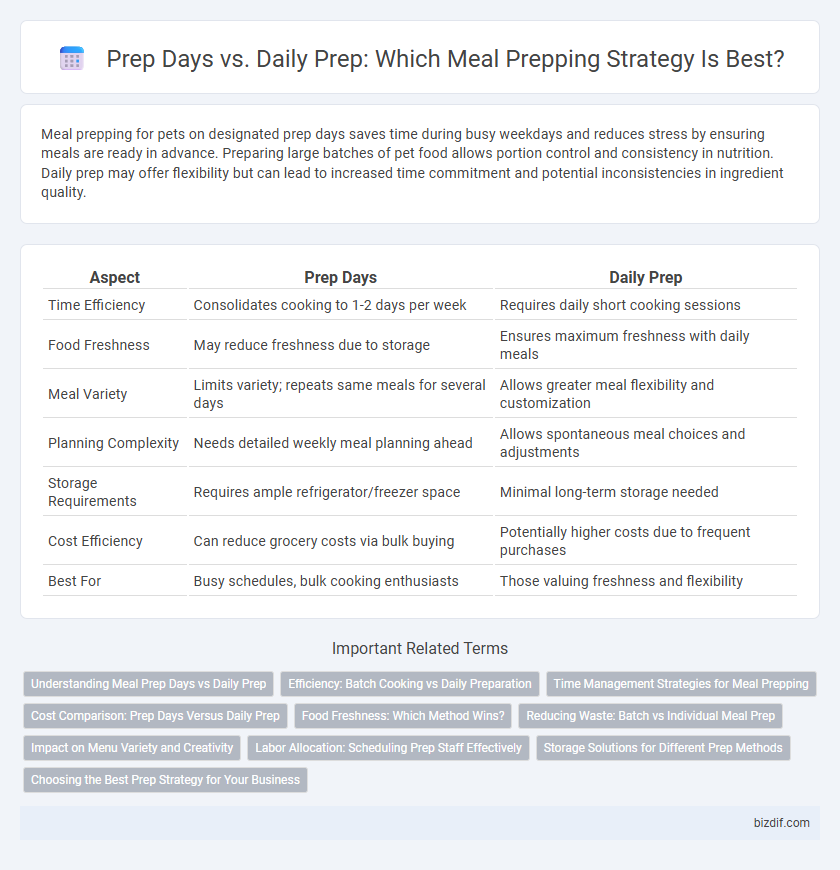Meal prepping for pets on designated prep days saves time during busy weekdays and reduces stress by ensuring meals are ready in advance. Preparing large batches of pet food allows portion control and consistency in nutrition. Daily prep may offer flexibility but can lead to increased time commitment and potential inconsistencies in ingredient quality.
Table of Comparison
| Aspect | Prep Days | Daily Prep |
|---|---|---|
| Time Efficiency | Consolidates cooking to 1-2 days per week | Requires daily short cooking sessions |
| Food Freshness | May reduce freshness due to storage | Ensures maximum freshness with daily meals |
| Meal Variety | Limits variety; repeats same meals for several days | Allows greater meal flexibility and customization |
| Planning Complexity | Needs detailed weekly meal planning ahead | Allows spontaneous meal choices and adjustments |
| Storage Requirements | Requires ample refrigerator/freezer space | Minimal long-term storage needed |
| Cost Efficiency | Can reduce grocery costs via bulk buying | Potentially higher costs due to frequent purchases |
| Best For | Busy schedules, bulk cooking enthusiasts | Those valuing freshness and flexibility |
Understanding Meal Prep Days vs Daily Prep
Meal prep days involve dedicating a specific time each week to cook and portion meals in bulk, saving time on busy weekdays and ensuring consistent nutrition. Daily prep requires preparing smaller portions or individual components each day, offering flexibility and freshness but demanding more frequent time investment. Choosing between meal prep days and daily prep depends on personal schedule, dietary goals, and convenience preferences.
Efficiency: Batch Cooking vs Daily Preparation
Batch cooking during prep days maximizes efficiency by allowing multiple meals to be prepared simultaneously, reducing overall cooking time and minimizing daily cleanup. In contrast, daily preparation requires consistent time investment each day, which can be less efficient for busy schedules but offers fresher meals with more variety. Utilizing large batch cooking aligns with optimizing kitchen resources, minimizing food waste, and streamlining nutrition management throughout the week.
Time Management Strategies for Meal Prepping
Meal prepping on designated prep days maximizes efficiency by batching cooking tasks, reducing daily time spent in the kitchen to under 30 minutes. Splitting meal prep into daily sessions allows for flexibility and fresher meals but can consume 60 to 90 minutes each day. Prioritizing bulk chopping, batch cooking proteins, and portioning meals on prep days optimizes time management while maintaining nutritional quality throughout the week.
Cost Comparison: Prep Days Versus Daily Prep
Meal prepping on designated prep days typically reduces overall food costs by enabling bulk purchases and minimizing ingredient waste, whereas daily prep often leads to higher expenses due to frequent shopping and smaller portion buys. Bulk buying during prep days takes advantage of grocery store discounts and reduces packaging costs, significantly lowering the cost per serving compared to daily meal preparation. Choosing prep days over daily prep can save up to 30% on food expenses monthly, making it a more budget-friendly option for consistent meal planning.
Food Freshness: Which Method Wins?
Meal prepping with dedicated prep days often ensures consistent food freshness by batch-cooking and properly storing meals for several days, reducing daily effort and minimizing spoilage risks. In contrast, daily prep allows for the use of fresher ingredients, preserving nutritional value and taste but requires more time investment every day. Choosing between the two depends on whether meal longevity or ingredient freshness is the priority for optimal eating experience.
Reducing Waste: Batch vs Individual Meal Prep
Batch meal prep significantly reduces food waste by using ingredients efficiently in larger quantities, ensuring that perishable items are fully utilized before spoiling. Individual daily prep can lead to more frequent ingredient spoilage due to smaller, inconsistent usage and leftover produce. Choosing batch prep lowers packaging waste and energy consumption, as meals are cooked and stored in bulk rather than multiple times throughout the week.
Impact on Menu Variety and Creativity
Prep days allow for extensive menu variety and creativity by dedicating focused time to experiment with diverse recipes and ingredient combinations. Daily prep offers flexibility but often limits creativity due to time constraints and repetitive meal patterns. Choosing prep days can enhance culinary exploration and maintain a dynamic, flavorful meal plan throughout the week.
Labor Allocation: Scheduling Prep Staff Effectively
Efficient labor allocation during meal prepping hinges on distinguishing prep days from daily prep routines, allowing managers to schedule staff based on workload intensity. Prep days require concentrated manpower to handle bulk ingredient preparation, while daily prep involves lighter tasks suited for fewer workers, optimizing labor costs. Strategic scheduling balances staff availability with task demands, ensuring consistent productivity and minimizing labor downtime.
Storage Solutions for Different Prep Methods
Meal prepping on designated prep days requires robust storage solutions such as airtight containers, vacuum-sealed bags, and stackable glass jars to maintain freshness over several days. For daily prep methods, smaller, easily accessible containers and reusable silicone bags offer flexibility and convenience, allowing for quick portioning and minimizing waste. Choosing appropriate storage based on the prep method enhances food preservation, reduces spoilage, and streamlines meal organization.
Choosing the Best Prep Strategy for Your Business
Choosing the best prep strategy for your meal prepping business depends on factors such as menu complexity, order volume, and equipment capacity. Prep days optimize efficiency by batching ingredient preparation and cooking, reducing labor costs, and minimizing waste. Daily prep offers fresher meals and greater flexibility to accommodate customer preferences and last-minute orders.
Prep days vs daily prep Infographic

 bizdif.com
bizdif.com